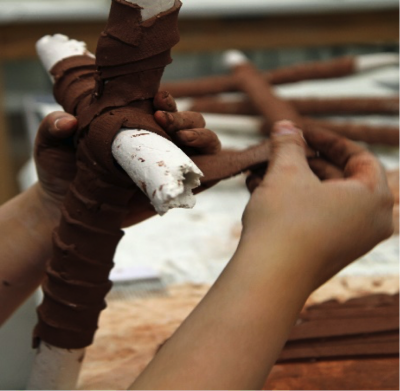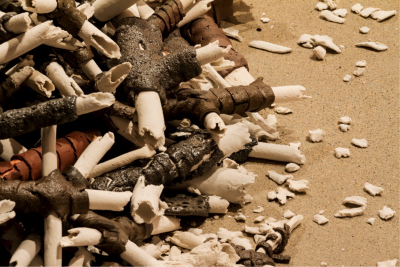In 2012, I created a large-scale sculptural installation for my Master of Fine Art thesis exhibition titled, everyone is fallen except for us fallen…. While the installation was created for a specific event, its creation marked the beginning of a journey that would eventually bring the work to rest in Chile’s Atacama Desert. As the work evolved, vague fragments of dreams started to drift through my mind. I dreamt of returning with the work to Chile, of anchoring myself in the place of my birth with the weight of my work. At first, the thoughts took a more conventional form–– perhaps I could exhibit the work in a traditional venue? But when I tried to focus on that path, the sound of wind arose in my mind. It was the sound of the Atacama Desert––the sound of desolation, hope, stories, and eternity. I began to dream of somehow building the mound in the desert near Calama, where death had come to the unprepared, where enduring women searched the endless sands. With my inherited fear of the Chilean authorities, I dreamt of clandestine art drops and of guerrilla art under a cloudless night sky witnessed only by stars. I envisioned myself in my late sixties after scraping together the funds needed for the journey, standing alone in the Atacama Desert listening to the wind.
But an unexpected gift that emerged from this large-scale work was that it brought me into the orbits of the other artists—Roewan Crowe, Doris Difarnecio, Christina Hajjar, and Helene Vosters—with whom I would form the artist collective CONSTELACIONES. When I told them about my vision of a return, we nurtured, shaped, and enhanced my dream fragments into a shared reality. This period of intense creative collaboration gave rise to a bold return to Chile in the summer of 2016, under the light of the desert sun with our performance Return Atacama.
The title for the original installation was drawn from a stanza of the moving poem, “Song for His Disappeared Love” by celebrated Chilean poet Raúl Zurita.
Now everyone is fallen except for us the fallen.
Now the entire universe is you and I minus you and I.
After the blows ended, we moved a bit and destroyed I was the
only one you felt come closer.
Now no one will know, but it’s you I look for, who I care for.
Weeping for you perhaps we are all one thing.
Now I know it but it doesn’t matter. [1]
From Zurita’s poem, I chose the line “everyone is fallen except for us […] fallen” for my ceramic sculptural installation, as it resonated with the underlying emotions motivating the work. The sculpture was a physical manifestation of my process of exploring the chain of historical events that lead to my family’s exile from Chile after the 1973 coup, bringing us first to Argentina and eventually to Canada in 1977.
The installation consisted of hundreds of figurative cross forms symbolizing the human figure, which acted as markers for the unmarked, disappeared, displaced, and repressed victims of a violently tumultuous era. The cross forms, which vary in size and shape, were constructed from terracotta and porcelain, and were fused together by the heat of the kiln. White “bone” forms were wrapped in terracotta bindings impressed with the pattern of fabric, referencing the burial shrouds found in the mass graves where the Chilean military admitted to burying the bodies of the disappeared, as well as the shroud-clad Incan mummies found in the Andes. [2] The Inca carefully wrapped their sacrifices before offering them to the sky, demonstrating their preciousness. Likewise, my meditative act of binding these crosses in strips of “material” was essential to the formation of these cross shapes, as it symbolized the care that should have been given to the violated dead.

This work was fueled by my inherited grief and the memories that came from the stories of the silenced, those forced into exile, and those who survived and remained behind in Pinochet’s Chile. My personal narrative comes from the memories of my mother who––at age twenty––managed to escape through the mountains to Argentina with me, her six-month-old infant. They come from my then twenty-three-year-old father who joined us after his release from the political detention camp he had been forced into after my birth. The stories that my parents chose to share with me were mostly of growing up in pre-Pinochet Chile and not of the dark times after the coup. But the few dark stories they did share hinted at a pain and bewilderment still so vivid decades later that I always hesitated to probe too deeply, not wanting to add to their heavy burden of carrying those memories. This lead me to delve into my own research as I grew older, which in turn offered me a deeper insight into the traumatic losses that my parents suffered.
As the wrapping of the white porcelain forms in their terracotta bindings progressed, I found that all of the images, passages of text, and oral histories from my research kept moving through my mind over and over again, finally blurring together in their vileness. As cross form after cross form was wrapped, this distressing amalgamation began to expose a deep well of anger and grief within me that I hadn’t realized I possessed. I would sometimes find it difficult to continue the process of wrapping and would have to abandon the work for days in order to regain my composure. By returning to the work, again and again, I moved through what my mother describes as “falling into the darkness,” which is how she refers to Chileans who are so mired in the pain of their memories that they lose themselves. I finally mourned the losses that I had suffered: the loss of the connections I will never truly have to country, extended family, and shared culture. All of this was severed by my family’s exile.
The cross shapes were then layered one on top of the other, some broken, ends splintered and sandblasted to evoke the sense that they have fallen into the space, a mound of memory for a missing generation. The weight of the ceramics anchors the sculpture, but its hold on the shape is fragile as nothing but gravity joins the forms into their rough mound. The attempt to carelessly remove any of the cross forms could result in the destabilization of the whole sculpture––a metaphor for what can happen when an entire generation is silenced. Remove the voices of dissent and there is no one there to stop the slide into madness. The pieces of splintered “bone” are interspersed throughout the mound; they also spill out around it as an homage to the surviving Women of Calama, whom I learned about through Patricio Guzman’s film Nostalgia de la Luz (2010). [3]

These women, who live in a small town in the Atacama Desert, comb the surrounding desolation in search of the bodies of their disappeared husbands, fathers, brothers, and sons. Mostly, they find only small bits of bleached bones. The missing men––predominantly miners––were victims of the “The Caravan of Death,” a military-led death squad that terrorized Chile in the months following the Coup in order to silence any resistance to the new regime.[4] Day after day, these women carefully sift through countless pebbles, overturn larger stones, and dig shallow holes in the hope that they may one day find a fragment of a loved one large enough to test for DNA. As the decades pass, some of the women have died, others have been defeated by exhaustion. Those that continue to search must do so knowing that the remains of their loved ones may be forever secreted in the sands of the Atacama.
While the women of Calama continue their search, others who lived through the military coup and Pinochet’s dictatorship long to forget the past, choosing instead to focus on the future. This is their choice. As an artist, I chose to make my peace with this past by creating a work that remembers. Through its sheer mass, I created a sculpture that could not be easily moved, hidden, or ignored. Now, as the last iteration of the sculpture sits in the Northern part of the Atacama Desert that sparked its creation, the wind moves over it, eroding it, layering it––and by extension myself––over the land of my birth.
Notes
[1] Raúl Zurita, “Song for His Disappeared Love/Canto a Su Amor Desaparecido,” translated by Daniel Borzutzky (Notre Dame: Action Books, 2010).
[2] Jonathan Franklin, “Chilean army admits 120 thrown into sea,” Guardian, 9 January, 2001, https://www.theguardian.com/world/2001/jan/09/chile.pinochet/.
[3] Patricio Guzmán, dir., Nostalgia de la luz (Pyramide Films, 2010).
[4] Patricia Verdugo, Chile, Pinochet, and the Caravan of Death (Miami: North-South Center Press: University of Miami, 2001), 133-51.
Patricio Guzmán, dir., Nostalgia de la luz (Pyramide Films, 2010).
Raúl Zurita, "Song for His Disappeared Love/Canto a Su Amor Desaparecido," translated by Daniel Borzutzky (Notre Dame: Action Books, 2010).
Verdugo, Patricia. Chile, Pinochet, and the Caravan of Death. Miami: North-South Center Press: University of Miami, 2001. Franklin, Jonathan. "Chilean army admits 120 thrown into sea." Guardian News and Media, Accessed https://www.theguardian.com/world/2001/jan/09/chile.pinochet.